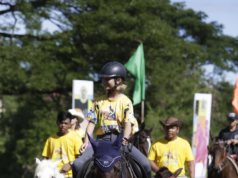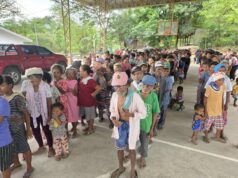GUIMBA, Nueva Ecija – The National Irrigation Administration is pushing for a change in the cropping calendar, making two plantings in the dry season in a bid to upscale palay production in the country.
Farmers may still plant rice during the rainy season but if NIA administrator Eduardo Guillen would have his way, he would rather have farmers engage in ratooning during the period traditionally considered the main cropping.
Guillen led the Harvest Festival hosted by NIA Upper Pampanga River Integrated Irrigation System (UPRIIS) Division V headed by acting manager Engr. Roberto Matias under department manager Engr. Gertrudes Viado in Barangay Tampac 1 here Monday, March 25.
Guillen was particularly impressed that farmers here have yielded an average of 14 to 15 tons – with one who reportedly got as high as 19 tons – a hectare amid the El Nino phenomenon.
He said inbred seeds yield an average of six tons and hybrid 14 tons a hectare during summer. Inbred though proves better result than hybrid during wet season, he explained. “Kaya nga ang gusto ng NIA mag-dalawang cropping tayo sa dry season.”

The first should start in October instead of December under the existing calendar.
“Sisimulan halimbawa namin ng October aani tayo ng February. Tanim ulit ng February-March ani ng June-July. Nakadalawang cropping na tayo ng dry season which is mas mataas ang yield,” he said.
He suggested that farmers do the ratooning during rainy season. “Tag-ulan at tag-bagyo na yan kung ako naman si farmer at ayaw ko nang mag-capital, ratooning naman ako,” he said, saying ratooning entails less expenses.
By ratooning, roots and growing apices of rice plants are left during harvest to let them fruit again.
To supply water to more areas, NIA bids to put up more solar- powered irrigation facilities.
“Dito natin maipapakita na, of course, kahit na may El Nino ay mataas pa rin ang ani ng ating mga magsasaka,” Guillen said noting that only 6,000 hectares in the tail-ends from over 147,000-hectare service areas of UPRIIS were left unirrigated this season.
Farmers in affected areas, he claimed, were assisted through the agency intervention such as provision of assistance from the Department of Social Welfare and Development, Department of Labor and Employment, and other agencies.
“Yung iba naman ay nag-high value crops,” he said.
Donna Lim, senior vice president of hybrid rice producer SL Agritech, said they ceaselessly produce better seeds and assist farmers by transferring technology towards the realization of the government’s rice sufficiency program.
They have also come up with seeds for wet cropping, she added.





